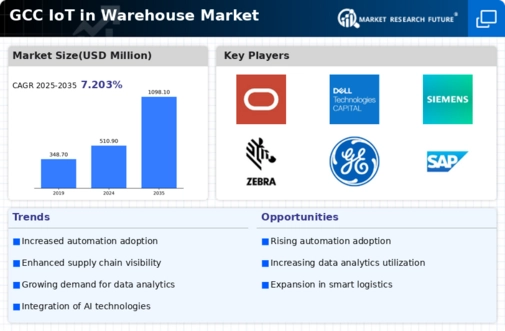Growing E-commerce Sector
The rapid expansion of the e-commerce sector in the GCC is a significant driver for the IoT in-Warehouse Market. With online shopping becoming increasingly popular, there is a pressing need for efficient warehousing solutions to manage the rising volume of orders. IoT technologies enable real-time inventory tracking and automated order fulfillment, which are essential for meeting customer expectations. Reports indicate that the e-commerce market in the GCC is projected to reach $28 billion by 2026, further emphasizing the need for advanced warehouse management systems. This growth in e-commerce is likely to propel the adoption of IoT solutions in warehouses, making it a key driver in the market.
Rising Demand for Efficiency
The IoT in-Warehouse Market is experiencing a notable surge in demand for operational efficiency. Companies in the GCC are increasingly adopting IoT solutions to streamline their warehouse operations, thereby reducing costs and enhancing productivity. The integration of IoT technologies allows for real-time monitoring of inventory levels, which can lead to a reduction in excess stock by up to 30%. This efficiency not only minimizes waste but also optimizes space utilization within warehouses. As businesses strive to remain competitive, the focus on efficiency is likely to drive further investments in IoT solutions, making it a critical driver in the iot in-warehouse market.
Advancements in IoT Technology
Technological advancements are playing a pivotal role in shaping the IoT in-Warehouse Market. Innovations such as improved sensors, machine learning algorithms, and cloud computing are enabling more sophisticated data collection and analysis. These advancements facilitate predictive maintenance, which can reduce equipment downtime by as much as 25%. Furthermore, the ability to integrate various IoT devices enhances the overall functionality of warehouse management systems. As technology continues to evolve, it is expected that the adoption of these advanced IoT solutions will accelerate, further propelling the growth of the iot in-warehouse market in the GCC.
Focus on Supply Chain Resilience
The emphasis on supply chain resilience is becoming increasingly critical in the IoT in-Warehouse Market. Companies in the GCC are recognizing the importance of robust supply chains that can withstand disruptions. IoT technologies provide enhanced visibility and control over supply chain operations, allowing businesses to respond swiftly to changes in demand or supply. By leveraging IoT solutions, companies can achieve a more agile and responsive warehouse environment, which is essential for maintaining competitiveness. As organizations prioritize resilience in their supply chains, the adoption of IoT technologies in warehouses is expected to grow, further driving the iot in-warehouse market.
Government Initiatives and Support
Government initiatives aimed at promoting digital transformation are significantly influencing the IoT in-Warehouse Market. In the GCC, various governments are investing in smart city projects and digital infrastructure, which includes the implementation of IoT technologies in logistics and warehousing. For instance, funding programs and incentives for businesses adopting IoT solutions are becoming more prevalent. This support not only encourages innovation but also fosters a conducive environment for the growth of the iot in-warehouse market. As these initiatives gain momentum, they are likely to attract more investments and drive the adoption of IoT technologies in warehouses.

















Leave a Comment